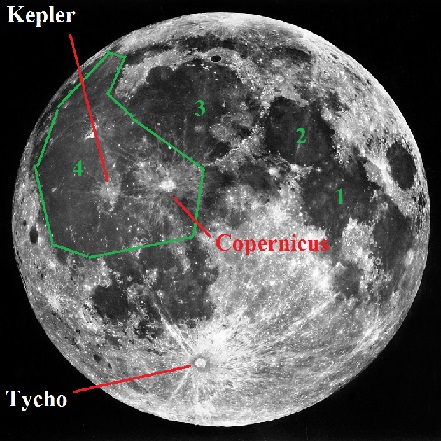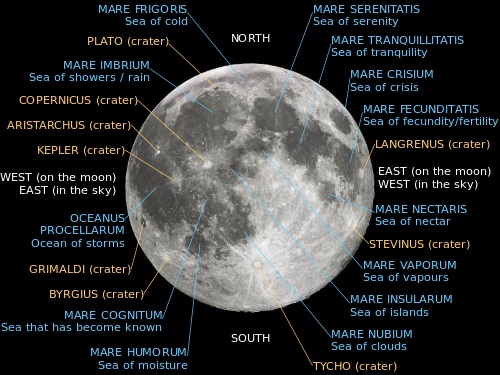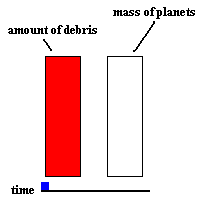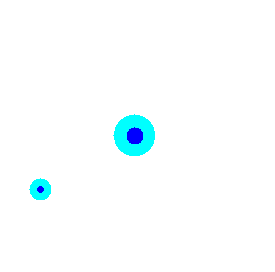The Moon
The moon is our closest neighbor in space and the only natural satellite
to orbit Earth. It has a lower density than Earth (3.3 g/cm3
vs. 5.5 g/cm3) and is about ¼ the size of Earth. The moon
has no atmosphere, no magnetic field, and only 1/6 the surface gravity of Earth.
It orbits Earth in such a way that it always keeps the same face towards
Earth.
The side facing Earth consists of dark (basaltic) lava filled basins called mare (maria) or seas. The lighter areas are heavily impacted terrain called the highlands. These contrasting features can easily be seen with the naked eye.

Major Seas (Maria)
1. Sea of Tranquility (Mare
Tranquillitatis) .... hey, Neil Armstrong's footprints are there!
2. Sea of Serenity (Mare Serenitatis)
3. Sea of Rains (Mare Imbrium)
4. Ocean of Storms (Oceanus Procellarium) which is outlined in green
Major Impact Craters
Tycho
Kepler
Copernicus
Can you find each of these features in the image at the top of the page?
 This map has lots more details.
This map has lots more details.
The lack of a lunar atmosphere means there is virtually no erosion at the moon's surface (the exception are micro-meteorites and particles from the sun known as the "solar wind" which still pelt the surface on an on-going basis). It is easy to see why the moon lacks an atmosphere - low gravity. Gas molecules in our atmosphere are in a constant state of motion, and would quickly escape Earth if it were not for our stronger gravitational field. At the surface of the moon, gravity is only 1/6th the earth's surface value and any gas molecule would have sufficient speed to escape this smaller gravitational force.
The Apollo astronauts brought back over 800 pounds of moon rocks from both the maria and highlands and found that the maria formed 3.2 - 3.8 billion years ago and the highlands are even older ... some highland rocks dating up to 4.5 billion years old (the oldest Earth rocks are about 4 billion years old ... and very rare). The maria represent areas which are topographically low terrain (basins) where lava pooled and quickly solidified. They represent the very last time the moon was geologically active.
The first clue to the origin of the maria comes from their shape - circular. We know from the heavily cratered, older highlands that there was once a lot of debris hitting the moon. Each impact leaves a circular crater. Large impacts would have created deep basins and also shattered much of the underlying bedrock. If there was any molten rock trapped in the underlying layers, this would have provided a perfect way for it to migrate to the surface. There it would pool in the deep basins, cool and solidify, ... forming a maria. Apparently this is what happened on the moon 3.2-3.8 billion years ago. Since that time two things changed. The moon's interior cooled to the point where it solidified (remember that levels of radioactivity decrease with time). The lack of any magnetic field supports this suggestion. Also, the number of large impacting objects (hitting the moon) radically decreased as well. This is evident by the relatively smooth, unaltered surface of the maria.


Taken on July 20, 1969 by Apollo 11 astronaut Buzz
Aldrin (left) Ejected material from Copernicus in white
(right)
Credit: NASA
There is a very thin layer of lunar soil known as regolith. Samples show it consists of microscopic rocks known as breccia, which are small fragments of "shocked rocks" cemented together. It is formed as a result of impacts. The craters Tycho, Copernicus, and Kepler shows quite clearly that when an object strikes the moon, it leaves a circular impact basin but also an eject blanket which can extend far from the impact sight. This is pulverized rock (powder) which rains down to the surface, creating regolith.
This page
shows a YouTube video of a rotating moon. It shows the both the side that
always faces us as well as the side always hidden from us on Earth.
|
The Eastern limb (left) and back side taken by Apollo 16 |
Credit :Clementine UV-VIS camera |
The back side of the moon (the side we never see) was first photographed by a Russian unmanned satellite named Luna 3 in 1959 (No wonder many of the features were given Russian names). The striking difference is that the back side has almost no maria. The exact reason for this is still a matter of debate, but the most likely answer may be a result of a thicker lunar crust on the back side. There is plenty of evidence of huge impacts on the back side .... resulting in some huge basins. However, a thicker crust would have prevented lava from the deeper interior from escaping to the surface.
This suggests that the moon, Earth, and other planets all formed (rather quickly) from this smaller debris that was floating around. Astronomers call this the planetesimal hypothesis. Although we can't look back in our own solar system ... astronomers can look at other young stars, and this is exactly what they see ... evidence of debris orbiting in a disk around these stars (the first found was around a star called Beta Pictoris). The asteroid belt and Kuiper belt gives us clues about the earlier state in our own solar system. Astronomers believe that the entire solar system 4.6 billion years ago (the common date of most meteorites) was much like these areas. Under gravity, these smaller objects collected into larger and larger objects (by collisions) until they reached planetary sizes. It would also explain why the rates of impact would suddenly cease. As the planets grow (from the collection of these smaller objects), there would be less and less of these smaller objects floating around as time went on. By 3.2 billion years ago, most were swept up into planets. The planetesimal hypothesis received another boost when planets (exoplanets) were discovered orbiting other stars. The count is over 5,000 in 2022.
 (animation)
(animation)
The bad news is ... not all of these objects are gone. Estimates are that there are several thousand rocky fragments ˝ mile in diameter which have Earth crossing orbits, and they will hit Earth sooner or (hopefully) later.
Fission Theory - The Earth was initially rotating so fast that a blob of mantle material was flung out into space ... forming the moon. This idea seems ridiculous but was actually taught in my grade school. This would explain why the moon had such a low density and accounts for the Pacific Ocean basin. Modern computers allow all kinds of possible simulations and at no time does it offer this solution.
Capture Theory - To account for the differences in density, simply have the moon form somewhere else in the solar system (where the planetesimals have a lower density) . Then it has to migrate from there and get captured by the earth's gravity as it moves past. Astronomers have a problem getting the moon dislodged from its initial position and have bigger problems getting it captured by Earth. In computer simulations, the passing moon either crashes into Earth or gets whip lashed to a remote location.
Double Planet Theory - The moon and Earth formed together, from the same debris, and at the same time. Why, then, would they not have the same density?

The Collision-Ejection Model (animation)
No adequate theory held up. That is, until the Giant Impact Hypothesis (also known as the Collision Ejection Theory) was proposed. It suggests that during the very early process of accretion of planetesimals, two large worlds were forming about 1 AU from the sun. Eventually one object (about the size of Mars and known as Theia) collided (at a glancing angle) with the other (which was about the size of Earth). The collision put large amounts of debris in orbit around Earth, which quickly coalesced, ... forming the moon. This theory explains the similarities between Earth and moon rocks. In addition, the energy from the impact depleted any volatile gasses and the ejected material would have been mostly low density, mantle type rocks, ... so the moon would have a lower overall density. This hypothesis is consistent with the idea that collisions were plentiful in the early ages of the solar system. Maybe the best part is that this scenario is played out in computers, and it actually works. So far, it is the best hypothesis used to explain why we have our moon. If this was the case, Earth once had a system of rings (like Saturn) long, long ago.
It still remains a mystery why "our" side of the moon looks so much different from the back side. We know the crust is much thicker on the back side. Some theories rely on tidal forces in the early formation to produce this asymmetry. Others have proposed an early impact near the south pole blasted huge amounts of debris towards the back side. Still other ideas involve a collision between two moons which formed around Earth (an extension of the collision-ejection model). Maybe you have an idea????
ŠJim Mihal 2004, 2014, 2022, 2024 - all rights reserved